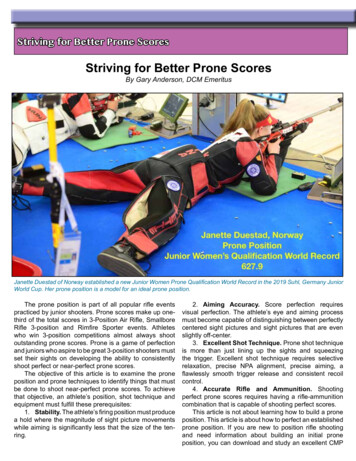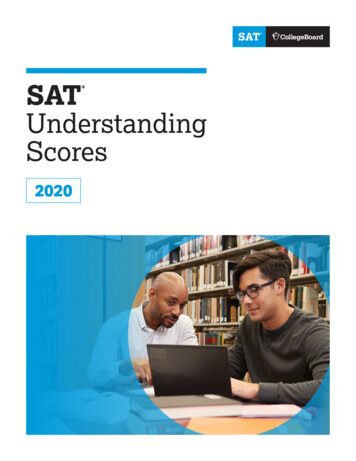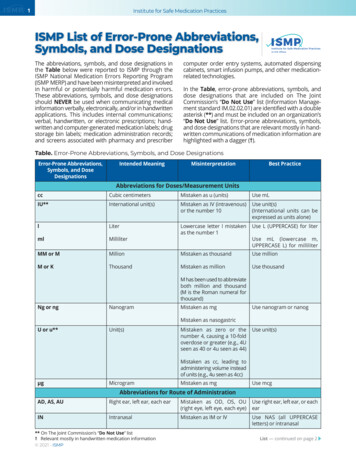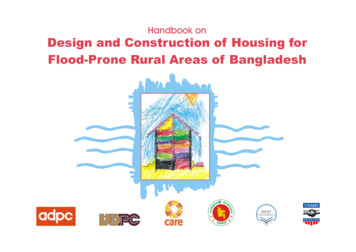
Transcription
6Striving for Better Prone ScoresStriving for Better Prone ScoresBy Gary Anderson, DCM EmeritusJanette Duestad of Norway established a new Junior Women Prone Qualification World Record in the 2019 Suhl, Germany JuniorWorld Cup. Her prone position is a model for an ideal prone position.The prone position is part of all popular rifle eventspracticed by junior shooters. Prone scores make up onethird of the total scores in 3-Position Air Rifle, SmallboreRifle 3-position and Rimfire Sporter events. Athleteswho win 3-position competitions almost always shootoutstanding prone scores. Prone is a game of perfectionand juniors who aspire to be great 3-position shooters mustset their sights on developing the ability to consistentlyshoot perfect or near-perfect prone scores.The objective of this article is to examine the proneposition and prone techniques to identify things that mustbe done to shoot near-perfect prone scores. To achievethat objective, an athlete’s position, shot technique andequipment must fulfill these prerequisites:1. Stability. The athlete’s firing position must producea hold where the magnitude of sight picture movementswhile aiming is significantly less that the size of the tenring.2. Aiming Accuracy. Score perfection requiresvisual perfection. The athlete’s eye and aiming processmust become capable of distinguishing between perfectlycentered sight pictures and sight pictures that are evenslightly off-center.3. Excellent Shot Technique. Prone shot techniqueis more than just lining up the sights and squeezingthe trigger. Excellent shot technique requires selectiverelaxation, precise NPA alignment, precise aiming, aflawlessly smooth trigger release and consistent recoilcontrol.4. Accurate Rifle and Ammunition. Shootingperfect prone scores requires having a rifle-ammunitioncombination that is capable of shooting perfect scores.This article is not about learning how to build a proneposition. This article is about how to perfect an establishedprone position. If you are new to position rifle shootingand need information about building an initial proneposition, you can download and study an excellent CMP
Summer 2019continued.instructional video titled “Building the Prone Position” athttp://vimeo.com/30815959. A brochure titled “TeachingRifle Positions to New Shooters” can be downloadedfrom the CMP website at Positions.pdf. A book published bythe CMP, Coaching Young Rifle Shooters*, includesdetailed instructions for beginning prone shooters.Rechecking the Prone PositionProne position stability begins with a structurallysound position. The first step in achieving stability is tobe sure the athlete’s position is structurally sound. Keyposition features to recheck are:1. Left Elbow Location. The left elbow, arm and slingprovide primary support for the rifle and upper body. Theleft elbow should be located directly under an imaginaryline running from the left hand to the left foot. A coach cancheck this by looking at a position from above. Anotherway to check is to determine whether the support triangleformed by the upper arm, lower arm and sling is trulyvertical. In a good prone position, this structure supportsall of the weight of the rifle and much of the weight of theupper body. If this support structure tilts either in or out,that will cause the position to change during shooting. Avertical support triangle contributes to position stabilityand consistency.2. Sling Support. Effective use of the slingcontributes to rifle stability. Placing the sling high on thearm is usually best. Configuring the sling so it pulls morestrongly from the outside of the arm prevents a pulse beatthat can be created when the sling pulls off of the inside ofthe arm where it would press against the brachial artery.Sling tension should be adjusted so the sling supports100 percent of the rifle weight. This allows the musclesof the left arm and shoulder to be completely relaxed andprevents using these muscles to do any lifting to supportthe rifle. Adjusting sling tension (length) is a matter offinding a balance between too loose and too tight. A slingthat is too loose may require muscle effort to support therifle. A sling that is too tight forces the right shoulder backand distorts the position.3. Rifle Height and Head Position. A higher proneposition creates less strain and a better head position.A low rifle position is not more stable and if the anglebetween the left forearm and floor is less than 30 degrees,the position is illegal. Keeping the butt-plate well up in theshoulder and close to the neck helps to establish a goodhead position. A good head position facilitates unstrainedaiming where the eye looks forward, not up.Definitions in this article: Hold. The magnitude of front sight movements over theaiming bull while aiming. NPA. Natural point of aim—where the front sight naturallywants to point when the position is relaxed. Cant. Tipping the rifle to the right or left while aiming. On-Call/Off-Call Shots. A fired shot is “on-call” when itslocation on the target closely corresponds with howthe shooter called that shot.THE SUPPORT TRIANGLEThe support triangle formed by the left upper and lower arm andthe sling must be positioned so it is vertical, not tipped.This athlete has an ideal left forearm angle of about 40 degrees.This in turn provides for an excellent head position whereaccurate aiming is facilitated.* Coaching Young Rifle Shooters was written by the author ofthis article, Gary Anderson. Copies can be ordered through the CMPE-Store “Bookstore” (from the CMP home page, click on “Sales,”“E-Store” and “Bookstore.”)
8Striving for Better Prone ScoresRELOADING TECHNIQUEThese athletes in an ISSF World Cup 50m 3-position final are loading with their rifles remaining in their shoulders. Their riflesremain in place after each shot while their right hands move only enough to operate rifle actions and place cartridges in their rifles.Placement of the head on the cheek-piece is a simplematter of dropping the head down to the cheek-piece.Stretching the head and neck forward to bring the eyecloser to the rear sight is wrong and creates unnecessarystrain. Solve this problem by moving the rear sight furtherto the rear. An adjustable cheek-piece should be set upto provide full support for the face. When shooting rifleswithout adjustable cheek-pieces, it is usually necessary tofix the head position by placing the jawbone on the cheekpiece. Some athletes may experiment with canting the rifleto improve the head position. This is OK if the cant angleis the same for every shot.4. Mark and Record All Adjustments. A keyto position consistency is using the same equipmentadjustments for each shooting session. Once equipmentadjustments are worked out, it is important to mark themand also to record them in a Shooter’s Log. Adjustmentswith Sporter Class air rifles and Rimfire Sporter rifles arerestricted to hand stop locations on the fore-end and slinglengths. Precision smallbore and air rifles have numerousadjustment possibilities that must be worked out, markedand recorded.5. Basic Shot Technique for Prone. Prone slow-fireshot technique is comprised of five phases: 1) shoulderingthe rifle and relaxing the position, especially the left armand shoulder, 2) aligning the sights and bringing them ontothe aiming bull while breathing normally, 3) starting theshot by exhaling and applying initial pressure on the triggerwhile starting to aim, 4) perfecting front sight movementsover the aiming bull while smoothly adding final pressureto the trigger to break the shot and 5) calling the shot andfollowing through as the rifle recoils. Since prone holds arerelatively stable and can remain centered for longer periodsof time, trigger pressure should be applied smoothly andgradually over a period of two to three seconds (gradualsmooth trigger pressure).6. Loading Technique. Loading the rifle while keepingit in the shoulder contributes to better prone scores becausethis helps to maintain position consistency. To do this, keepthe rifle in the shoulder after each shot and use the righthand to operate the action and load pellets or cartridges. Itmay be possible to keep the right elbow in place or it maybe necessary to lift the entire arm. Minimizing body andrifle movements during reloading makes it easier to keepthe position’s NPA centered from shot to shot.Advanced Prone Position DetailsThere are some prone position details that are notcovered in beginning shooter instruction. The athlete whowants to advance to the top ranks must, nevertheless,dedicate attention to several additional details necessaryfor perfecting the position.
Summer 2019continued.1. Position Structure. Initial instruction recommendsestablishing a body angle to the line of fire of 20 to 30degrees. Some outstanding prone athletes reduce thatangle to as little as 10 degrees so we can say the bodyline of fire angle should be between 10 and 30 degrees.If a coach views a prone position from above, two otherposition structure details are clearly visible. The left sideline that determines left elbow placement is easy to check(see illustration on right). The other structural feature tocheck is the alignment of the shoulders and spine. Theyshould form a “T.” To be avoided is a position where theright shoulder is pushed back by placing the left hand toofar out on the fore-end.2. Feet and Leg Positions. An ideal prone positionrotates the body slightly onto its left side. This takespressure off of the stomach and mitigates a possible sourceof pulse beat tremors. It also makes breathing easier. Theposition of the feet and legs determines how the body isrotated. Body rotation is achieved 1) by turning the left footso the heel points up or to the right and 2) by splaying theright leg out or by bending the right knee and shifting itforward. The position of the right leg or knee controls howmuch the torso is rotated onto the left side.3. Right Arm Position. The right arm serves twopurposes in prone. It functions as a brace to stabilize theupper body and position. It should bear little or no weight,no more than five percent of the upper body weight. Itssecond purpose is to place the right hand and index fingerin position for properly pulling the trigger. The diagram (onpage 10) illustrates a model right hand and arm position.In evaluating the right-hand position, pay close attentionto trigger finger function. The tip of the index finger shouldcontact the trigger just ahead the first joint. With a lighterprecision smallbore or air rifle trigger, trigger contact maybe in the middle of the first finger phalanx. Position thisIn addition to looking for a body-line of fire angle of 10 to 30degrees, keys to good position structure include placing theleft elbow under the left side line (red line) and aligning theshoulders and spine so that imaginary lines through both forma “T.”hand and finger so that this contact point presses directlyto the rear, never to the side. The hand’s grasp on the pistolgrip should be handshake firm with a Sporter air rifle orRimfire Sporter rifle but may be lighter with a precision rifle.Proper body rotationisachievedbyturning the left foot,so the heel pointsup or the toe pointsto the right. Theright leg must beextended out or theknee bent and drawnup. Note how in thefront view diagram(inset) the shouldersare tilted so thatthe right shoulder ishigher than the left.
10Striving for Better Prone Scoresessential to stop experimenting andpractice being absolutely consistentfrom shot-to-shot. A vital aspect ofposition consistency is making sureshoulder and cheek pressures andany restraints on the rifle such as slingThe right elbow (a) andtension or right-hand grip tension areupper arm act as a brace consistent from shot to shot. Positionto stabilize the position. consistency, always shooting theway for every shot, every day,They support little or no sameis absolutely critical.weight. The lower armAiming Systems. Front6.andrearsight adjustments selected(b) and wrist should befor prone also influence the athlete’sstraight so that theyscore capabilities. Wearing correctiveplace the hand andlenses when necessary and adjustingtrigger finger (c) in thethe size or location of the rear sightaperture are essential for keepingproper position to pullthe sight picture sharply focused.the trigger directly toFront sight ring size is critical. For anthe rear.experienced shooter, the ring must belarge enough to contain all aiming bullmovements during aiming but not solarge as to make precise alignment4. Left Arm and Shoulder Relaxation. Letting thesling do all the work in holding up the rifle, learning to more difficult. A prone front sight ring should be smallerrelax the left hand, left arm and upper body and eliminating than one used for standing.muscle tremors in that support system all greatly contributeto hold stability. The rifle should rest on the hand near thebase of the thumb. With a Rimfire Sporter and its fixedhand stop a light grip is necessary, but hand slippage canbe prevented by wearing a non-slip glove. With a precisionair or smallbore rifle, the hand should rest against the handstop with the hand and fingers completely relaxed. Whenthe sling supports the weight of the rifle, it becomes possibleto totally relax the left arm and upper body. Athletes shoulduse a breathing technique to help them do this. Breathenormally while bringing the aligned sights onto the aimingbull, but each time you exhale, relax the left arm andupper body by consciously telling those muscles to “letgo.” Doing this effectively takes practice. It may help topractice this exhale-relax and let go technique while doingholding exercises in the prone position in front of a blankwall or even in a dark room.5. Position Consistency. It should be clear by nowthat there is no such thing as one perfect prone position.The best prone shooters adopt a variety of minor variationsthat do not violate basic structural requirements for a goodThe components of an ideal sight picture include a clearlyposition. Athletes should feel free to fine tune their positions focused sight picture (front sight and bull) and a properly sizedwith variations that are comfortable and most effective for front sight ring (aperture). Adjusting the rear sight aperture sizethem. However, once they work out their positions, it is and placement keeps the sight picture sharply focused.RIGHT HAND ANDARM POSITION
Summer 2019continued.7. Rifle and Ammunition Accuracy. To consistentlyshoot Xs or 10s, the rifle and ammunition must be capableof producing X or 10-ring accuracy in test conditions. Matchgrade ammunition or pellets are almost always necessary.Ammunition manufacturers and major distributors nowoffer testing services to match lots of ammunition or pelletswith competitors’ rifles or an adult with bench rest skillsmay be recruited to test rifle-ammunition combinationsfor team members’ rifles. Especially with smallbore rifles,regular barrel cleaning is necessary to maintain accuracy.Prone Technique – Striving for PerfectionHaving a structurally sound position and correct shottechnique will produce excellent prone scores, but thereis still more to be done to consistently produce winningprone scores. Techniques described here are fundamentalto top-class prone shooting:1. Hold Stability. The first prerequisite for shootinggreat prone scores is having a position that producesa hold where there is little or no perceptible front sightmovement. Beginning shooters are instructed to centertheir hold movements over the aiming bull, but an advancedprone shooter should be able to hold the rifle so steady thathe/she sees little or no front sight movement. Striving forprone perfection requires continuing to practice techniquesthat contribute to prone stability, letting the sling do all thework in supporting the rifle, developing an effective innerposition (see #4 on page 12), learning to relax the left hand,left arm and upper body and eliminating muscle tremors inthat support system.2. Mental Standards. An athlete’s mental standardsfor what constitutes an excellent score make a real differencein the scores he/she will ultimately be able to shoot. Youngathletes should study the scores it takes to win, not just inthis country, but in international championships. Expect todevelop a prone position that produces holds with little orno perceptible front sight movement and expect to shoot100s prone.3. Centering the NPA. One of the keys to pronesuccess is developing a position with a precise NPA andbeing able to center that NPA as perfectly as possible.After doing lots of prone position shooting and becomingtotally comfortable with his/her position, an athlete shouldbecome capable of seeing and feeling (inner position)when the NPA does not settle on the aiming point. Beforeeach shot, relax and let the front sight ring settle whereit naturally wants to point. If the front sight settles off thetarget, it is necessary to move the whole body left or right,CENTERING AN OFF-CENTER NPA1) After relaxing the position, the front sight settles at 8 o'clock.2) Correct the off-center NPA by easily pushing the front sight in adirection opposite to the off-centered NPA.3) Let the front sight settle back to its new NPA. Sometimes two or threeminor corrections are necessary.
12Striving for Better Prone ScoresSHOT TECHNIQUE IN PRONEAiming – Trigger ControlInner Position – Breathing– RelaxationInner Position – Breathing – RelaxationTimeSec. -808The diagram illustrates the relative times during the firing of prone shots when attention must be devoted to breathing, relaxationand the inner position and when attention is also focused on aiming and trigger control.or forward or to the rear, to correct the NPA. If the frontsight ring settles on the target, but not on the aiming bull,adjust the off-center NPA by nudging the shoulders andupper body to push the front sight ring through the aimingbull and allowing it to settle back onto the bull. Two orthree attempts may be necessary to get the NPA to settleon the aiming bull. Preparation for prone slow-fire shotsmust devote a few seconds before each shot to relaxing,checking the NPA and, when necessary, correcting theNPA onto the aiming bull. When shooting indoors on 10bull targets, it is necessary to adjust the NPA before eachshot.4. The Inner Position. Shooting positions have anouter or externally visible position and an “inner position,”which is concerned with what is happening inside theathlete’s body while holding the rifle and firing the shot.Advanced prone shooters pay close attention to how theirinner positions feel. They check for muscle relaxationand feel whether their NPA is centered. They strive foran inner calmness that contributes to stable holds. Theinner position is concerned with breathing, relaxation andcentering the NPA. All are important in preparing to fireaccurate shots.5. Precise Aiming. Top-class prone scores can onlybe achieved when the athlete strives to make every sightpicture as perfect as possible. Accepting small aimingerrors sooner or later leads to shooting nines on someof those shots. The front sight ring must be preciselycentered over the aiming bull. Precise NPA alignmentproduces closely centered sight pictures but final perfectsight pictures are achieved by applying extremely light,precise muscle pressures to the rifle.6. Pulse and Tremor Reduction. Many shooters,even good ones, complain about seeing pulse beats intheir front sight movements. Others report that their frontsight movements never really become still. An athlete whoexperiences these types of hold movements must devotespecial efforts to finding their causes and to making minorand often subtle changes to eliminate or reduce them. Pulsebeat movements can come from how the sling is placedon the arm or from how the body lies on the ground. Avoida prone position where the body lies flat on the ground.Placing the sling higher or lower and making sure it pullsmore off of the outside of the arm may make a difference.Tremor movements can come from tensions in the bodythat may be reduced by selective relaxation.7. Consistent Recoil Control and Follow-Through.Off-call shots, especially shots that were called tens butended up in the nine ring are usually caused by somethingthe athlete changed. The usual cause for off-call shots isnot that the rifle or ammunition changed but that the shooterchanged. In prone, the athlete places pressures on thebutt-plate and cheek-piece as well as tensions on the slingand pistol grip. Those pressures and tensions affect howthe rifle is allowed to recoil. Since the rifle starts to recoiland jump up while the bullet or pellet travels through the
Summer 2019continued.The CMP now conducts National Smallbore Rifle ProneChampionships during the annual National Matches atCamp Perry. Aspiring young shooting athletes can competewith and learn better prone shooting from the best proneshooters in this country in these championships.barrel, changing those pressures or tensions changeshow the rifle recoils. That in turn changes the point ofimpact on the target, even with air rifles. To keep shotson-call, the pressures and tensions the shooter placeson the rifle must be absolutely consistent and they mustremain consistent until the shot is well out of the barrel.Hence the critical importance of follow through. To finisha shot correctly, the athlete must 1) call the shot asprecisely as possible and 2) continue to focus on thesight picture and how the rifle recoils. If the rifle jumpsand returns to the aiming bull after recoil, that is good,but if the front sight ring ends up off of the bull after recoilthat is a sign that there are stresses in the position thatdo not allow the rifle to recoil freely.A great prone score alone won’t win a three-positioncompetition, great standing and kneeling scores arenecessary as well. However, today’s 3-position scoresare now so high that achieving perfection in prone isnecessary to accompany great standing and kneelingscores and achieve winning 3-position.About the AuthorGary Anderson, Director of Civilian MarksmanshipEmeritus, retired as the full-time CMP Director at the endof 2009. He continues to work with the CMP as the seniormarksmanship instructor. During his remarkable career, hewon two Olympic gold medals, seven World Championshipsand 16 National Championships. He served as a VicePresident of the International Shooting Sports Federation(ISSF) from 1990 through 2018. He is a former NebraskaState Senator and Past President of USA Shooting. Heserved as a Technical Delegate for Shooting during the 2012and 2016 Olympic Games as well as for the 2014 and 2018World Shooting Championships.In 2012, the International Olympic Committee awardedGary Anderson with the OlympicOrder, its highest honor “foroutstanding services to theOlympic Movement.”In 2014, the CMP expanded itsworld-class air gun center at CampPerry and renamed the facility theGary Anderson CMP CompetitionCenter, in honor of Anderson’scontributions to the organizationand the marksmanship community.
Position Structure. Initial instruction recommends establishing a body angle to the line of fire of 20 to 30 degrees. Some outstanding prone athletes reduce that angle to as little as 10 degrees so we can say the body-line of fire angle should be between 10 and 30 degrees. If a coach views a prone position from above, two other posi.










